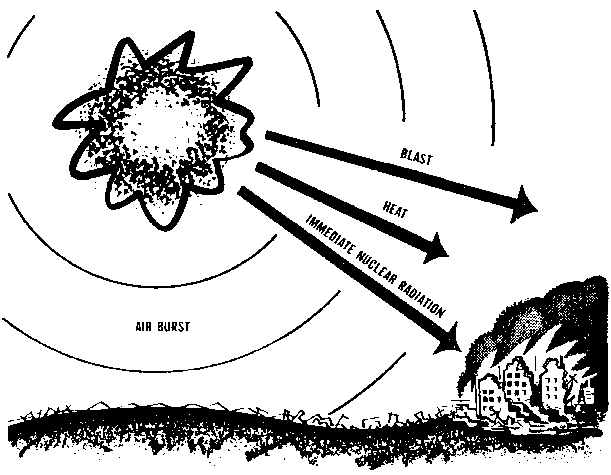
|
Bruce Beach Nuclear Survival Resources | ||
| Main Contents Page Here | Mirror This Site |
Programming Provided By: Civil Defense Rad Meter FAQ |
Make this your handbook for emergencies.
Keep it in a handy place so that you and your family can refer to it quickly should any emergency threaten.
Keep other emergency advice such as first aid and artificial respiration instructions, antidotes for poison, emergency telephone numbers, in the same place.
The Canadian Government has joined other peace-minded nations in doing everything possible to reduce world tensions, to assist in the settlement of international disputes by peaceful means and to achieve disarmament with such controls as are necessary to preserve the security of all nations. However, the awesome threat of a major nuclear war involving North America remains a factor in plans for the defence of Canada.
The nature and scale of a possible nuclear attack on North America, and the extent to which Canada would be involved in such an attack, cannot be predicted with accuracy. Our major centres would be at some risk of deliberate attack, random explosions could occur, and there would be the certainty of the danger from widespread, radioactive fallout over most of the Country.
Governments at all levels have made, and are continuing to make, preparations which will reduce the number of casualties, safeguard survivors and contribute to the capacity of this nation to survive and recover from such a tragedy. The purpose of this booklet is to assist individuals and families in making personal survival plans and preparations to guard themselves against the potential dangers of nuclear war.
Many of the precautions which are recommended will serve a double purpose in that they will save lives in peacetime disasters such as flood, tornado, fire, hurricane, blizzard, ice storm or earthquake. Attention has been directed to this important feature throughout the various steps.
All Canadians are urged to read "11 Steps to Survival" with care to act on the advice it contains and to keep it handy for emergencies.
Although protected by Crown Copyright, the contents may be reproduced in whole or in part provided proper acknowledgment of the source is made.
The Queen's Printer
Governments and communities at all levels are planning for the survival of our Nation in the event of a nuclear war. But the survival of individuals also will depend upon the preparation that each person makes. Persons ready to take the right action before and following an attack will increase their chances of survival.
This pamphlet describes what YOU can do before and following a nuclear attack. You can greatly increase your family's and your own protection by taking the Eleven Steps to Survival:
A nuclear explosion releases vast amounts of energy in three forms:
The amount of energy released depends upon the size and design of the weapon. A wide range of weapons and delivery systems are available to an aggressor and we have no way of knowing what size of explosions might take place in Canada. For illustration purposes, we describe in this pamphlet the effects of a 5-megaton H-bomb equal to the explosive force of five million tons of TNT. Such a bomb could substantially damage the largest Canadian city.
The effects depend upon whether the weapon is exploded high in the air, or on, or near the ground. An air burst usually produces more fire and blast-damage than a ground burst which results in a big crater and more radioactive fallout. The effects described below are approximate for a 5-megaton explosion and can only be approximate since effects depend upon a number of conditions such as weather, terrain, etc.


A blaze of light brighter than the sun is produced by a nuclear explosion. It lasts for about 15 seconds. Temporary blindness and eye injury can result from the glare if eyes are not shielded.
The heat rays from the explosion travel at the speed of light or about 186,000 miles per second. It can start fires up to 20 miles away. Many fires are caused when the heat pulse comes through a window to set fire to curtains, paper, clothing and furniture. The heat flash also can set fire to the outside of wooden buildings.
The following are some examples of the predictable effects on unprotected skin of the heat flash of a 5-megaton weapon exploded on a clear day:
Nuclear explosions in the air rather than on the ground are more likely to produce a greater number of serious burns through the heat flash. Clothing will give some protection. A shield between you and the light will give protection against burns from the heat flash.

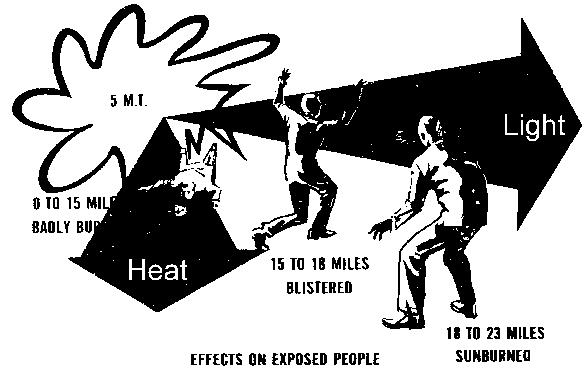
The blast wave travels more slowly than the heat flash. Several seconds may pass after you have seen the light or felt the heat before the blast wave reaches you, depending on the distance you are from the explosion. It is like the time between seeing the flash of lightning and hearing the sound of thunder. For example, at ten miles from the centre of an explosion, it would take about 35 seconds for the blast wave to reach you. If caught in the open during a nuclear explosion, this time can be used to find some protection from the blast wave.
You might be injured by being thrown about by the blast; therefore, keep low. The greatest danger is from flying glass, bricks and other debris. The blast from a 5-megaton explosion could injure people as far away as 15 miles.

The kinds of damage that the blast can do to buildings are:
A 20-megaton bomb increases the approximate ranges of damage described above to five, eight, sixteen and twenty-four miles.
These are approximate distances as the strength of buildings is not uniform. For example, reinforced concrete buildings are more blast resistant than wood frame structures. In some areas four miles away from the explosion, concrete buildings might be repairable, while wood frame buildings would be completely destroyed. Windows, of course, are very vulnerable and are apt to be blown in as far away as 25 miles from the explosion.
A nuclear explosion causes both immediate radiation and residual radiation.
Immediate radiation is given off at the time of the explosion. It is dangerous only within two or three miles. If you were near the explosion without adequate protection and managed to survive the effects of blast and fire, you could still be seriously affected by immediate radiation.
Residual radiation is given off by the radioactive particles left as "fallout" after the explosion. The danger from fallout would be so great and widespread that it is discussed separately, in >Step 2.
The illustrations below show some of the most probable situations in which you might find yourself at the time of a nuclear attack, and what you should do:
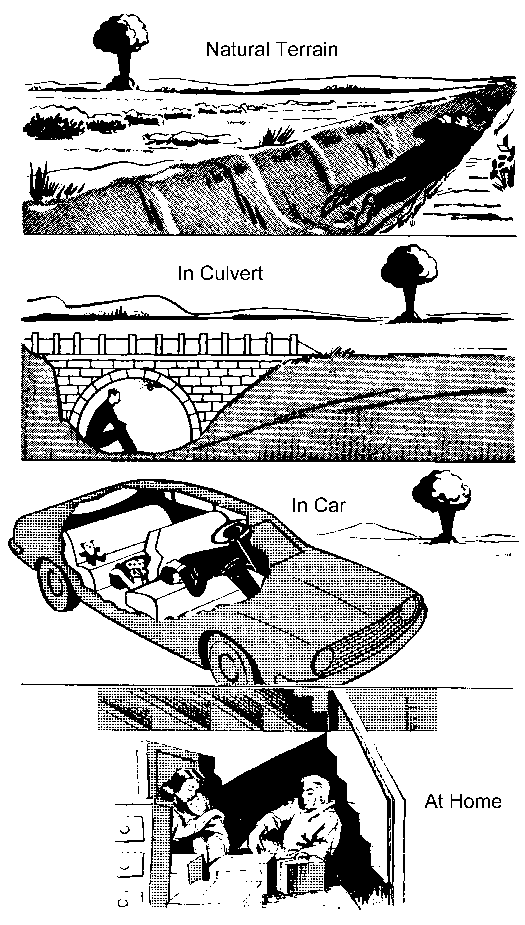
If a nuclear weapon is exploded on, or near, the ground, danger from radioactive fallout is greatest. The force of the explosion may make a crater up to a mile wide and to a depth of one hundred feet. Millions of tons of pulverized earth, stones, buildings and other materials are drawn up into the fireball and become radioactive. Some of the heavier particles spill out around the point of explosion. The rest are sucked up into the mushroom cloud.
This radioactive material is then carried by winds until it settles to earth. This is called "Fallout". Under some circumstances you may see the fallout; under others you may not.
The radioactivity it gives off cannot be seen. You can't feel it. You can't smell it.
But fallout doesn't come out of the sky like a gas and seep into everything. It can best be described as a fine to coarse sand carried by the winds. Because the wind direction varies at different heights above the ground, it is not possible to judge from the ground where the fallout will settle. It can settle in irregular patterns hundreds of miles from the explosion.
The fallout from a 5-megaton explosion could affect seriously an area of 7,000 square miles. If nothing were done to gain protection during the period of high radioactivity, there would be a grave danger to life in that area.
Because fallout is carried so far and covers such a large area, it could be the greatest danger to the largest number of Canadians in a nuclear war. If Canada was not hit by nuclear bombs, those exploding in the United States close to our border could result in serious fallout in many parts of Canada.
There are four things which determine the amount of radiation reaching your body from fallout:


The radioactivity in fallout weakens rapidly in the first hours after an explosion. This weakening is called "decay". After seven hours, fallout has lost about 90% of the strength it had one hour after the explosion. After two days it has lost 99%; in two weeks 99.9% of its strength is gone. Nevertheless, if the radiation at the beginning were high enough, the remaining 0.1% could be dangerous.
Radiation must be measured by special instruments handled by people trained to use them. But, if you stay in a shelter during the first days following an explosion, you escape the strongest radiation. You should stay in the shelter until radiation has been measured and you have been told aver the radio that it is safe to come out.
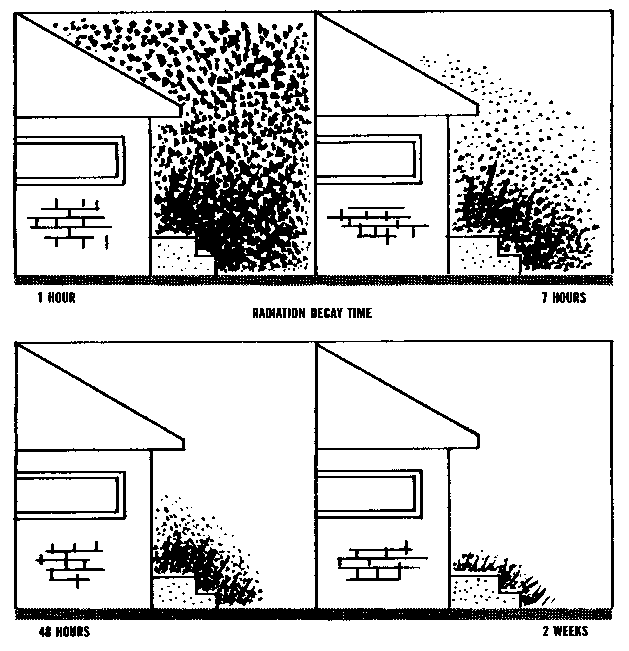
The strength of radiation reaching your body is reduced the farther you are from the fallout. Here are some illustrations of the safest place to be when you are in various kinds of buildings.
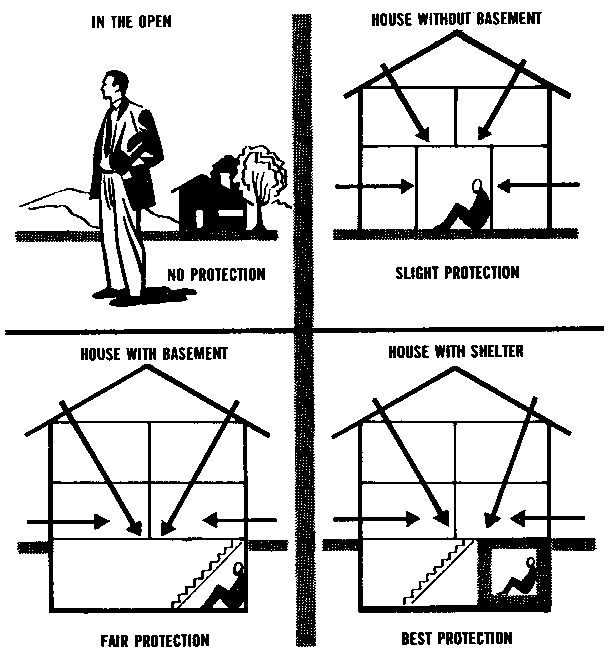
The most effective protection is to place some heavy material between yourself and the fallout. The heavier the material the better the protection. Many common materials give excellent protection. The materials and design of the fallout shelter recommended in Blueprint for Survival No. 1 will stop penetration of 99% of outside radiation.
These thicknesses of material will stop 99% of radiation:
A fallout shelter is the best way to protect your family and yourself against radiation because:
By providing your family and yourself with a fallout shelter, you are unlikely to suffer serious effects from radioactive fallout.
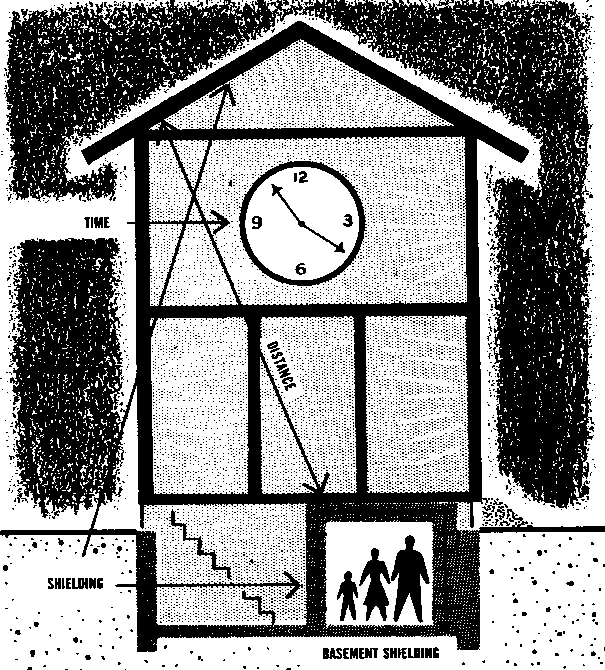
Radioactive particles in contact with your skin for a few hours may produce burns. Follow Step 9 to prevent this danger.
Radioactive particles swallowed in food or water might be harmful. Follow Step 9 to prevent this danger.
Radioactivity from an area of fallout may produce illness in the unprotected individual after a few days. Follow Step 4 to prevent this danger.
Radiation illness develops slowly. It cannot be spread to other people. Except for temporary nausea shortly after exposure, evidence of serious effects from radiation may only appear after an interval of from a few days to three weeks. A combination of loss of hair, loss of appetite, increasing paleness, weakness, diarrhoea, sore throat, bleeding gums and easy bruising indicate that the individual requires medical attention. Nausea and vomiting may be caused by fright, worry, food poisoning, pregnancy and other common conditions.
All Canadian communities where there is a likely need are provided, or will be provided, with sirens. Other areas should have warning arrangements based on local systems such as telephones, horns, bells or factory whistles.
Warning devices are only attention-getters. Dependent on the size of your municipality, the sirens, bells, telephones, etc., will sound the Attack Warning.
There is one type of siren warning signal in Canada:
The ATTACK WARNING Signal: A wailing (undulating) tone on the sirens of three to five minutes duration or short blasts on horns or other devices repeated as necessary means:
WHEN YOU HEAR THE WARNING SIGNAL, YOU SHOULD TAKE PROTECTIVE ACTION AND LISTEN TO THE RADIO FOR INSTRUCTIONS.
When the Attack Warning sounds, you must take protective action. Take a battery-powered radio with you. Broadcast advice and instruction may help to save your life. If you don't have a portable radio, turn up the volume of your house radio so that it can be heard in your shelter. If away from home you are forced to take emergency shelter and are near a radio-equipped vehicle, turn up the volume and open all the vehicle's doors or windows.
The Canadian Emergency Broadcasting System, a network of all Canadian radio and television stations which will be formed when a nuclear attack on Canada has been detected, will tell you when and how to take emergency protective action against possible attack and shelter against fallout if an attack occurs.
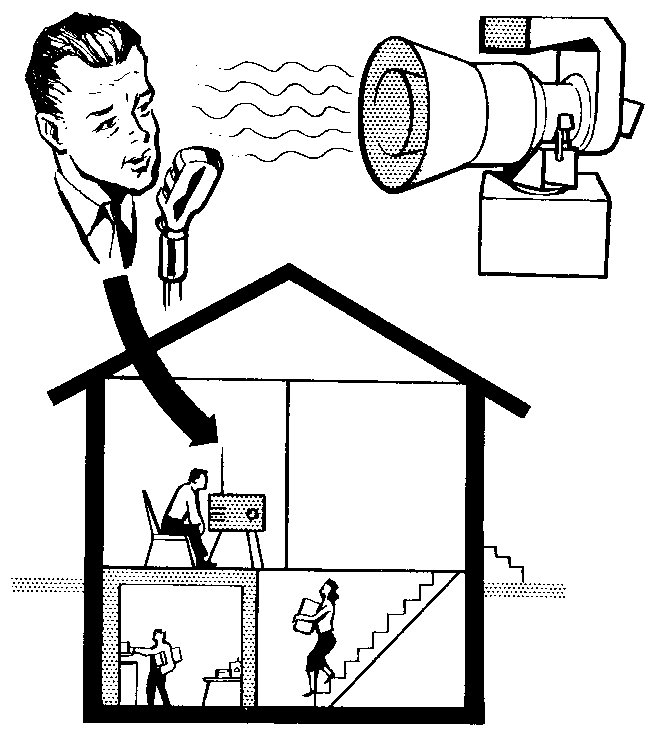
If sirens or warning systems signal impending attack, regardless of where you are or what you are doing, you must take the best available cover against the blast, heat and light effects of nuclear explosions.
Emergency broadcast instructions will include the following advice:
If sirens or warning systems sound following nuclear attacks, the warning may mean another attack or that radioactive fallout is approaching your area. You will be advised over the radio. If the advice concerns fallout, you must take cover against the fallout effects. (See Step 4).
Radio broadcasts will identify areas which will be affected by the fallout and give instructions and advice. These might include:
When the sirens sound don't use the telephone. Listen to a radio or television for information. In the event of an Attack Warning telephone lines will be required for official use.
It is important to provide your family and yourself with a shelter. But what kind of shelter? This is a decision you must make yourself after studying the problem.
Study your shelter requirements in the same way that you would study accident or fire insurance. Decide upon the degree of protection you want for your family and yourself. Shelter is your insurance against something you hope will not happen, but if it does, will give you protection.
Shelters of the type commonly used in Europe during the Second World War would not provide protection against the blast of a nuclear explosion. They were designed to withstand short shock pressures lasting something like 1/100th of a second. Shelters designed to withstand the pressures created by a nuclear explosion must be able to stand up to pressures lasting as long as 6 seconds. In addition, they must be capable of giving the occupants protection against fires outside the shelter as well as against radiation.
The fallout shelter is designed to give protection against radioactive fallout only. Because most people in Canada probably would not be affected by the blast and heat effects of nuclear explosions, protection against fallout is all that is required by them.
The type of shelter for good protection depends upon the distance it will be from the explosion. Unfortunately, it is not possible to know this in advance. That is why each individual must make his own decision when selecting the type of shelter he wishes to have.
Blueprint for Survival No. 1 gives details of a fallout shelter for the home in which you now live. If you rent the home, the decision to construct a shelter must be taken jointly with your landlord.
Blueprint for Survival No. 2 gives details of a fallout shelter for the new home you may be planning to build.
Blueprint for Survival No. 6 gives details of blast shelters which may be built outside the home.
These pamphlets are available from your local Emergency Measures or Civil Defence Organization.
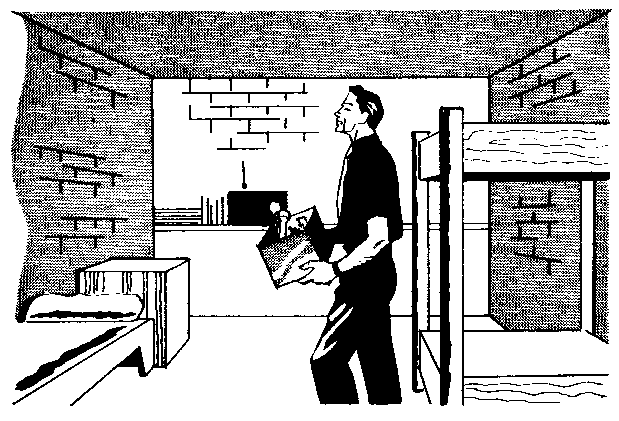
One of the simplest ways to improvise some anti-blast protection is to build a lean-to (bed springs or boards) against a work bench or heavy table, preferably in the basement, and pile mattresses on it and at the ends. If the material is readily available it could be built in a matter of minutes after the ATTACK WARNING is sounded and could protect you from loose bricks, flying glass, etc.
If you are in the open and there is a ditch or culvert within easy, quick reach, lie face down in it and cover your face with your arms. Make sure this shelter is not too close to buildings which could collapse into it.

"After" the blast and heat of the explosion, you would have to find other protection against fallout which will come down later. (Don't forget your battery-powered radio).
None of these improvisations is as good as a properly equipped blast shelter, but any single one of them could mean the difference between life and death.
You may not have a fallout shelter when warning of approaching fallout is broadcast. Here are some tips on how to increase your protection in a basement. The amount of protection you can build will depend on how much time you have available until fallout arrives.


If your home has no basement or crawl space, build your emergency shelter in that part of the house (centre hall or clothes closet) farthest away from outside walls and the roof. Build it as described for houses with basements. On the floor immediately above your shelter area, and against surrounding walls, pile up furniture, trunks, dressers, dirtfilled boxes or other heavy material which will reduce radio-active penetration into your emergency shelter.

Nuclear attacks on centres of production, and fallout conditions, may curtail the distribution of available food stocks for several days or even weeks following these attacks. Persons who had taken shelter against fallout might be advised to stay in their shelters for as long as 14 days. Those who had chosen to evacuate larger cities would be dependent largely on the resources available in reception towns. Because of these possibilities, it is recommended that every person should have emergency supplies. These supplies should include food, water, battery-powered radio, first aid kit, and where necessary, medical supplies as recommended in Step 7. Heavy clothing would be necessary in winter. Extra changes of clothing should be considered particularly stockings and underclothing.
For those who may choose to evacuate major centres, supplies must be selected carefully because of space limitation in the family car. Supplies should be packaged beforehand so that they can quickly be put into the car. See the pamphlet "Your Emergency Pack" available from your local Emergency Measures or Civil Defence Organization.
Many of the recommended items are already in your home.
Whether you choose to evacuate or take shelter locally, you should have a road map with you. You could then relate the information about areas under fallout, which you would hear about on the radio, to your actual location. Toys, games, books for your children would help to occupy their time if they had to remain in shelter from fallout. Your battery-powered radio will keep you in contact with the outside world.
The following is a suggested list of items from which your two weeks' supplies should be developed to be in your shelter or handy to it.
Coveralls, rubber boots, rubber gloves for adults. To be used in venturing outside even after instructions have been given that this is safe for short periods.
(See Step 7)
These are suggested items and amounts for each adult for 14 days in shelter. Check off the items as you stock them in the shelter and mark the purchase date on them. Food stored for emergency use should be used and replaced at least once a year.

Misinformation about the fire danger from nuclear explosions is widespread and common. For example, some persons believe that the fire-ball would completely incinerate a city. This is not true.
The heat from the fire-ball lasts about 15 seconds and would create fires which are no different from the fires you see in peacetime. They can be put out with water and extinguishers, and if each survivor were able to put out a small fire quickly, mass fires would not take place.
The heat flash from the fire-ball entering through windows and doors could set fire to curtains, clothes, furniture and paper. Other fires could break out in attics, in backyard trash, on wooden shingles and on the outside of houses built of wood particularly if they are unpainted or weathered.
Knowing how to prevent and fight fires at home and at work reduces the number of peacetime fires. The same knowledge will also reduce the number of fires caused by a nuclear explosion.
But how can you fight fires in the presence of fallout? From 5 to 15 miles from the centre of the explosion, there will be many survivors. Fallout will not start coming down for about 30 minutes. During this half hour, survivors should inspect their houses and put out all the small fires they can. They must not rely on the fire department to extinguish these fires.
You should have in your home and place of work, fire extinguishers, or in an emergency, create a water supply for fire fighting in pails, bathtubs, washtubs, etc. Don't rely on being able to use the established water supply system.
Even those who live in areas not attacked may find their fire departments will have to fight major fires elsewhere. Every householder should learn how to carry out fire prevention and know how to fight small fires. It may prove of value in peacetime!
Your local fire authorities are always anxious to advise you on how to fight fires. Attend any emergency fire fighting classes held in your area.
Here are some tips for an emergency:
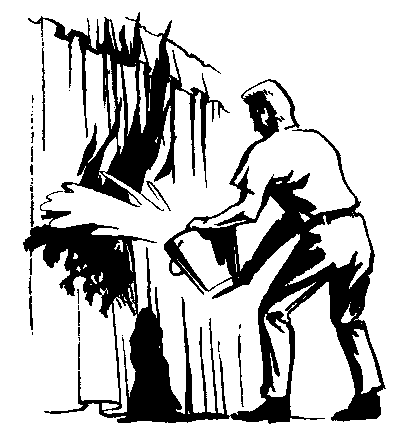
The acquisition of First Aid and Home Nursing skills prepares individuals to serve effectively in a national emergency. If such an emergency occurs, the care of many thousands of injured or seriously ill persons becomes a tremendous task for the organized health services. Doctors and nurses may not be readily available to assist you. Thus the importance of First Aid and Home Nursing skills takes on a new dimension. The survival of the injured or sick members of your family may become your responsibility.
The main objectives of training individuals in first aid and home nursing are:
Therefore you must:
A simple first aid box kept in your shelter or in your evacuation kit should contain:
NOTE: individuals requiring special medication such as insulin should maintain at least 100-days supplies.
General Rules:
Unconsciousness:
An unconscious patient lying on his back may be strangled by his own tongue which will tend to fall back and obstruct the airway. All unconscious persons should be placed lying half over on their faces, (three-quarter-prone position).
If the patient is breathing quietly and easily and his lips are pink and have no froth on them, breathing is not obstructed.
If the patient is breathing noisily and with difficulty, if his lips are blue and frothing, or if his chest is sucked inwards when he breathes in, his airway is obstructed and needs immediate attention.
Keep the airway clear by:
Placing the casualty on his back; supporting his shoulders on a pad of any suitable material available; tilting the head back with one hand on the forehead, the other lifting the neck.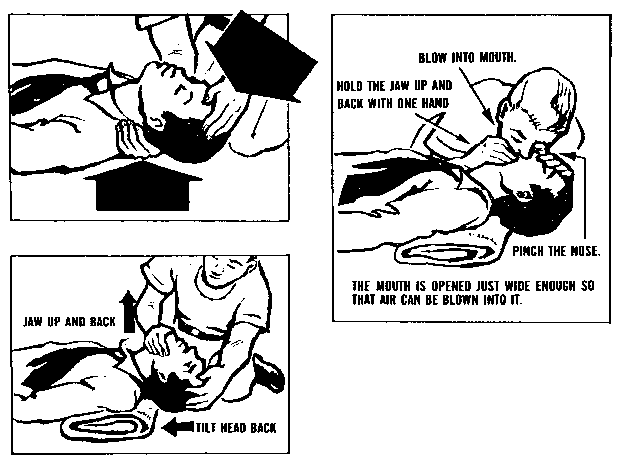
If his breathing stops you can breathe for the patient by blowing air into his lungs. Take a deep breath. Pinch the casualty's nostrils. Place mouth to mouth tightly. Blow into the casualty's lungs strongly enough to cause his chest to rise. The cycle should be repeated every 3 to 5 seconds for an adult and a little more frequently for a child. Blow more gently for a child or a baby, but strongly enough to make the chest rise.
Wounds:
You Must:
Cover the wound with a clean dressing to keep out dirt and germs. Bandage it on firmly to stop the bleeding. If a wound is bleeding profusely, hold it firmly with your hand until you can secure an emergency dressing. Any thick pad of clean, soft, compressible material large enough to cover the wound will make a good dressing. Clean handkerchiefs, towels, sanitary pads, tissue handkerchiefs or sheets make good emergency dressings.
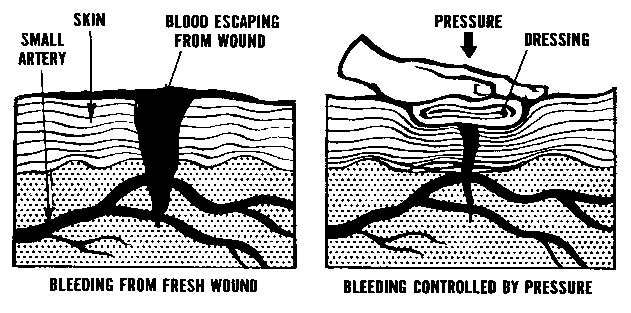
Burns:
Cover the burned area with large, thick, dry dressing and bandage it on firmly.
Encourage the casualty to drink plenty of fluids. A solution of salt and soda is useful to give to casualties with burns and to those who have suffered from serious bleeding.
Broken bones (fractures):
If a limb is very painful and cannot be used, appears to be bent in the wrong place or the casualty says he heard or felt the bone snap, it is likely that a bone is broken.
Sharp ends of a broken bone may damage important structures such as blood vessels and nerves. A broken limb should be steadied and supported to prevent movement of the broken ends before attempting to move the patient.
If a person's back or neck is so severely injured that he is afraid to move because of pain, or cannot move or feel his limbs, you should assume that he has a broken back. He should be moved on a hard, firm stretcher taking great care not to "jack-knife" him by picking up his feet and shoulders. Improvised stretchers can be made from a door, wide board, window shutter, etc. Fill in the natural hollows of the track and neck with padding and support the head on both sides to prevent movement.

Before medical or nursing help becomes available you may also encounter infant care problems. emotional problems and persons suffering from radiation sickness. What to observe, and what to do for these latter cases, is outlined below.
Breast feeding is preferable but, if not possible, then a formula using powdered or evaporated milk should be prepared under clean conditions.
If vomiting or diarrhoea occurs infants and children become dehydrated very quickly. To avoid this happening give frequent sips of boiled water.
If a rash or fever develops, keep others away from the sick child.
Persons who become emotionally disturbed following a disaster should be treated calmly but firmly. They should be kept in small groups, preferably with persons whom they know and encouraged to "talk out" their problem. If they are not otherwise injured they should be given something to do. It may be necessary to enlist the aid of one other calm person to help subdue the overexcited patient. If a stunned or dazed reaction persists over 6 to 8 hours this should be reported to a doctor or nurse immediately one becomes available.
The signs and symptoms of this illness are described in Step 2.
Treatment includes rest, the provision of whatever nutritional food and drink is available and personal encouragement to get well. Swab the mouth gently with mild, warm salt and water if it becomes sore. As these patients are susceptible to infection, keep wounds clean and covered with a sterile dressing. Separate these patients from persons with colds, rash or fever.
The following suggestions may help you care for your patient when proper equipment is not available.
Courses in these skills are available in most municipalities from your local St. John Ambulance Association or Canadian Red Cross Society.
Your limited supply of water will have to be rationed and used only for essential purposes. If you have enough warning time before the arrival of fallout, fill your bathtub, all available buckets and pans with water. And remember that there is an emergency supply in your hot water tank. (Don't forget this if in peacetime your water supply has been temporarily disrupted).
The problems of garbage and human waste disposal can be solved even if fallout keeps you in the shelter. Put all your garbage in tightly covered garbage pails. After using your emergency toilet, you should tie human waste in waterproof plastic (polyethylene) bags and place them in the garbage pail. Store a 14-day supply of the plastic bags. After the second day in the shelter, you may risk leaving it for a few minutes for essential tasks. Therefore, when your garbage container is filled, move it out of the shelter.
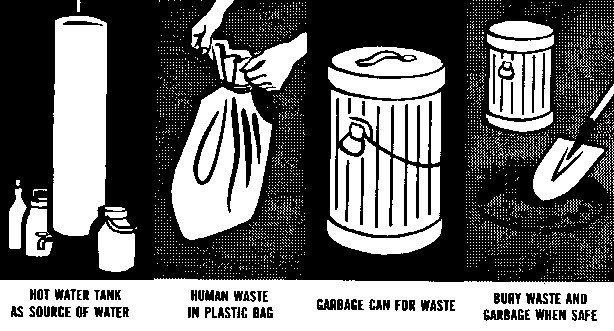
Keep a soft broom in the shelter for tidying it up.
Remember, personal cleanliness in crowded shelter conditions is important to you and your family.
If your area is free of fallout but is without sewage services, bury human waste and garbage in the ground. Dig the pit deep enough so that the waste will be covered by at least two feet of earth.
In Step 2, fallout was described as "sand". To remove the danger, remove the sand. If you suspect that your clothes have fallout on them, remove your outer clothing before you come inside your home and leave it outside. Don't shake these clothes inside the house or shelter. You would only scatter the fallout grit and create unnecessary danger to others. If you have water, wash thoroughly, particularly exposed skin and hair. But do not scrub your skin as this might rub in the radioactive particles.
Exposure to fallout does not make you radioactive.
Even if you are stricken with radiation sickness, this sickness cannot be passed on to others.
Fallout on your clothing or body would expose you and those close to you to radiation. If you suspect you have been exposed to fallout, you will not be a danger to others if you carefully get rid of your outer clothing outside the shelter and wash.
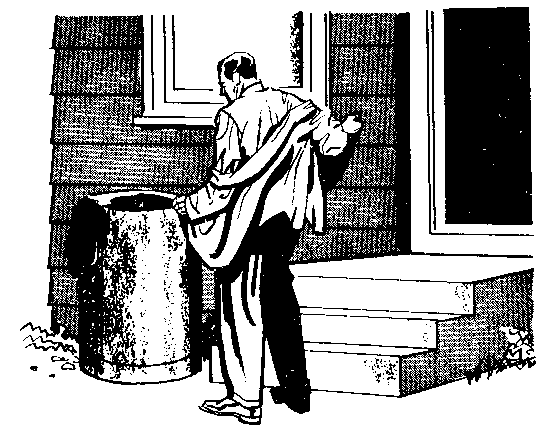

Since most of your food will be in tightly covered containers (cans, bottles, plastic, boxes), it will all be safe to eat or drink if you dust the containers. Food, if it is unspoiled and free of grit or dust, may be eaten during the emergency period.
Be sure to wash fruit and vegetables and peel carefully.
Water will be safe if it is in covered containers, or if it has come from covered wells, or from undamaged water systems.
It is important that your local municipality have a plan for a war emergency. And it is just as important that you know that plan.
Over the past several years, provincial and municipal governments, with the assistance of federal authorities, have been steadily developing plans for the protection of the population and the continuity of essential government services in wartime. Most municipalities in Canada have emergency plans to deal with both peacetime disasters and a nuclear attack situation. These include the details of how welfare, health, police, public utilities, fire and other emergency services will operate.
Some larger communities have developed plans to assist in the evacuation of those who would choose to leave before an attack or who might have to be evacuated as survivors or casualties following an attack. These plans include traffic arrangements to reception centres and medical facilities in nearby communities.
It would be unwise to try and prepare your own family survival plan without first checking to see how it fits in with municipal plans. This would be true whether you plan to go to a safer area before attack or remain at home. It is particularly important that you know and understand the arrangements to instruct the public about staying in shelter and coming out of shelter when it is safe. Fallout is a health hazard which will require countermeasures for personal and family protection including assessment of radiation and advice and instructions to those in shelter.
There must be close understanding and cooperation between the public and municipal authorities responsible for their protection.
Find out about your municipal emergency plans now and keep well informed about them as they are further developed.
If you know what is contained in the first nine steps, and you know your municipal plan for a war emergency, you should now make your personal and family survival plan. The success of your plan will depend on how many of the suggested recommendations you carry out. Your chances of survival increase as you carry out each recommendation.
Thinking about the problems with which you would be faced should nuclear attack be launched against North America is the first important step. Blast, light, heat and radioactive fallout are the problems. A workable survival plan will include all of the preparations you can make in advance to meet those problems.
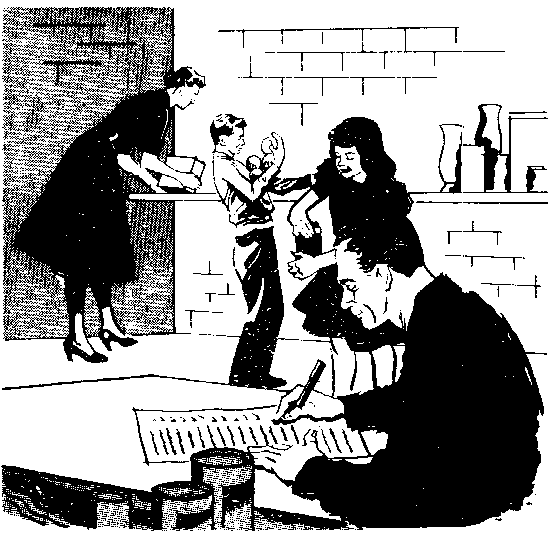
In making that plan, there are certain things you must know:
When the sirens or other warning devices sound and your local broadcast station confirms that an attack on North America has been detected it means that you must take protective action immediately. Would you and your family
Deciding where you will take initial protective action and where you and your family will seek shelter from fallout are two basic points which you must consider in making your survival plan. Can you answer the following questions about seeking immediate protection and shelter:
In thinking about what you will do or where you would go, you might consider leaving your home to find shelter elsewhere. Before you decide to plan on evacuation, consider the following questions:
If you don't have a fallout shelter built in your home, study the guide given in Step 4. It shows how you can improvise emergency home protection. Bearing in mind that density and distance between you and the fallout is necessary, try to estimate if there is enough material and furniture to build an emergency shelter in your basement or the central part of your house.
Based on the lists of emergency supplies suggested in Steps 5, 6, 7 and 8, try to answer the following questions:
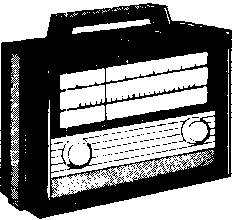
There are many other points which you and your family must resolve for a workable survival plan. This booklet provides most of the essential information on which to base your plans. Read the Steps again, and, as you review each Step, try to answer the questions which apply to your surroundings, your home, your family. Here are a few more which may help:
REMEMBER! YOU MUST PLAN FOR:
On the basis of what you've read and the questions and answers you've thought about, you should now make your survival plan and start making whatever arrangements you can. BUT MAKE SURE THAT ALL MEMBERS OF YOUR FAMILY KNOW YOUR PLAN AND WHAT TO DO WHEN THE TIME COMES.
The best way to arrive at a workable plan which will be remembered by your family is to practice it. If you plan on building an emergency shelter, try it now to find out if you have enough material, how much help you'll need, if your proposed area is large enough, and how long it will take to build. Locate and practice moving essential supplies, water, clothing, bedding, etc. Practice the essential things you would have to do.
If you plan to move to what you consider a safer location, make a practice run to make sure you know the quickest and safest route, that protection is available when you get there, and that you can carry all the supplies you think you'll need.
List for quick reference the important things to be done in the event of warning. As examples, note when and where all members of your family will take shelter at all times; where essential items of food, shelter and other supplies will be obtained; how shelter will be improvised; what windows must be blocked; if you plan on going to what you consider a safer area, details of the route and supplies you will need at your destination.
|
Bruce Beach Nuclear Survival Resources | ||
| Main Contents Page Here | Mirror This Site |
Programming Provided By: Civil Defense Rad Meter FAQ |